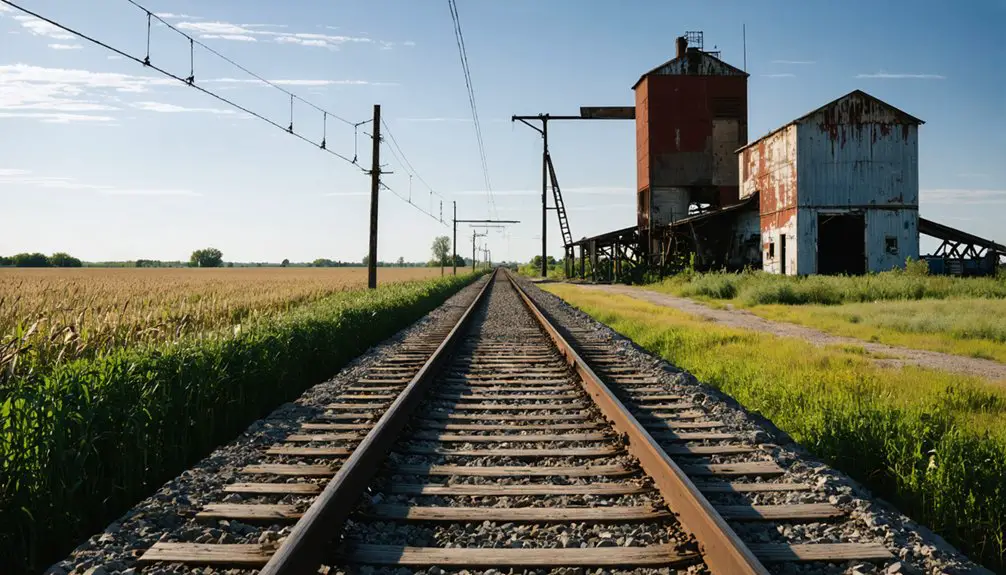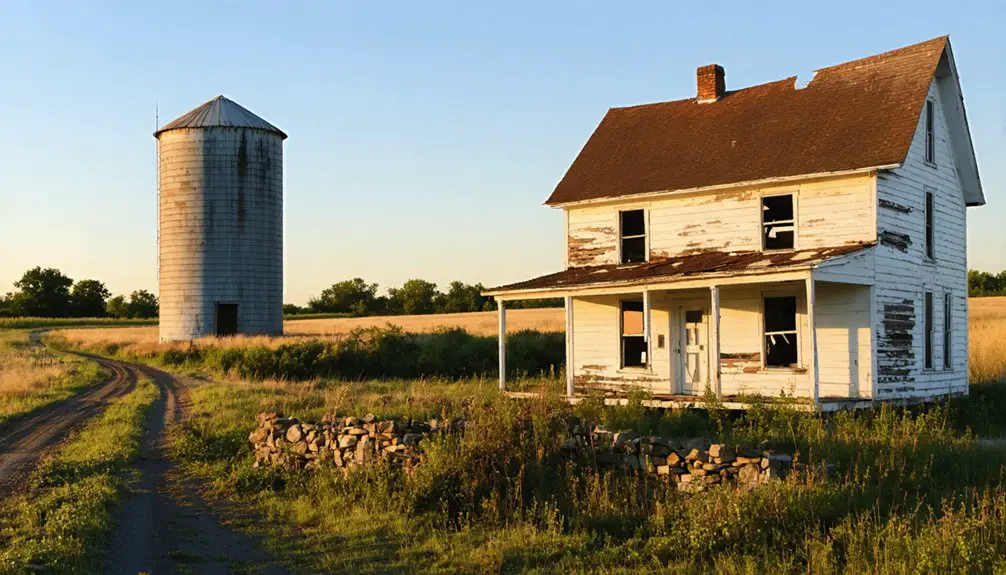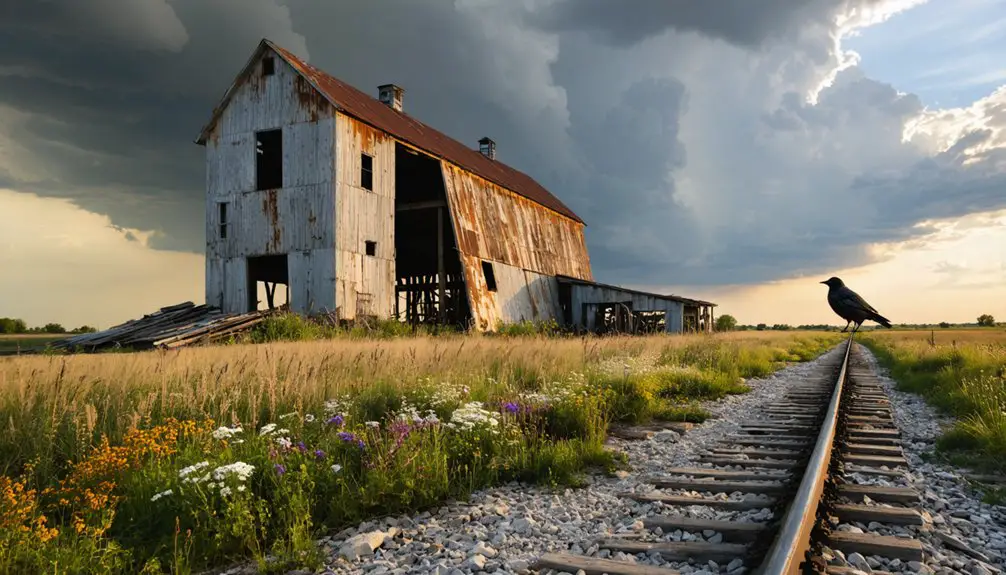You’ll find Vawter’s ghost town story in northern Bellevue Township, Minnesota, where the Minneapolis and Saulte Ste. Marie Railroad established a crucial transportation hub in 1908. The town quickly developed around St. John’s Lutheran Church and a one-room schoolhouse, with daily trains supporting local farmers and businesses. After losing its postal service and rail operations in the 1940s, this once-bustling agricultural community faded away, though its legacy holds deeper insights into Minnesota’s railroad era.
Key Takeaways
- Vawter, Minnesota was established in 1908 by the Minneapolis and Saulte Ste. Marie Railroad but became abandoned by the 1940s.
- The town’s decline began with the discontinuation of postal services and railway operations, leading to complete community abandonment.
- Located in northern Bellevue Township, Vawter thrived as an agricultural hub with a church, school, and grain elevator.
- The removal of rail service eliminated the town’s economic foundation, as transportation was vital for agricultural commerce.
- St. John’s Lutheran Church and a one-room schoolhouse served as central community institutions before the town’s abandonment.
The Birth of a Railroad Town
When the Minneapolis and Saulte Ste. Marie Railroad extended its tracks westward from Duluth in 1908, you’d have witnessed the birth of Vawter, a promising new settlement in northern Bellevue Township, Minnesota.
Similar to how local communities contributed to railroad development in Mankato during the 1860s, the Soo Line established this strategic point on John Schmolke’s property, choosing the location for its ability to serve as a crucial shipping hub.
As part of the region’s railroad expansion, the Soo Line established this strategic point on John Schmolke’s property, choosing the location for its ability to serve as a crucial shipping hub.
The town’s development quickly took shape around the railroad, with essential services emerging to support both residents and rail operations.
Like countless frontier settlements, Vawter grew organically around its lifeblood – the railroad tracks that brought commerce and community.
You’d have found a grain elevator, stores, and a creamery springing up to serve the community. The town’s shipping services ended in the 1940s.
The name Vawter itself might’ve come from “vater,” meaning water, reflecting the area’s characteristically wet conditions, though this origin remains unconfirmed.
Life in Early Vawter
If you’d visited early Vawter, you’d have seen daily trains bringing supplies and taking agricultural products to market while local farmers conducted their business at the general store and grain elevator.
Like other Minnesota towns, Vawter benefited greatly from the expansion of railroad infrastructure that helped establish the state’s farming economy.
You’d have found the community’s social life centered around the local church, where families gathered for both worship and important meetings.
The one-room schoolhouse served as an educational hub where children learned their lessons while forging lifelong friendships with their neighbors.
Similar to Agram Township, residents focused primarily on agricultural pursuits to sustain their livelihoods.
Daily Railroad Activity
The daily rhythm of life in early Vawter revolved around three distinct railroad activities: freight shipments, passenger service, and locomotive maintenance.
You’d find farmers gathering at the grain elevator to ship their harvests while steam engines stopped to refill with water, creating a bustling hub of activity along the Soo Line tracks.
Train schedules dictated the town’s pulse, with freight operations moving agricultural goods and supplies in and out of the community.
You could spot passengers boarding trains for Duluth or points west, while local businesses like the creamery and stores aligned their operations with arriving trains.
The railroad’s presence transformed this rural outpost into a crucial link in Minnesota’s transportation network, connecting you to distant markets and communities through the rails. The town’s strategic location helped serve diverse industries including grain and cattle that were vital to Great Northern’s success.
Like the Chicago Great Western line, local leaders advocated strongly for their preferred railroad routes to ensure their community would benefit from rail connections.
Church and School Life
Life in early Vawter centered around two essential institutions: St. John’s Lutheran Church and the local one-room schoolhouse.
You’d find most community activities happening at these crucial gathering spots, where families came together to strengthen their bonds and preserve their cultural identity. Church gatherings and school events served as the heartbeat of this small farming town, offering residents opportunities to socialize, learn, and support one another. Similar to Forestville State Park, these institutions helped maintain the town’s vitality until changing times led to their closure. Much like the thriving community of European immigrants that once populated the Banning quarry, Vawter’s residents built strong social connections through their shared experiences.
- St. John’s Lutheran Church provided spiritual guidance and hosted community festivals
- The one-room schoolhouse educated children in fundamental subjects and practical skills
- Both institutions acted as central meeting points for farming families
- Church and school functions helped maintain cultural continuity in the isolated settlement
- These community pillars fostered social connections until the town’s eventual decline
Local Business Operations
Beyond church and school gatherings, Vawter’s commercial landscape shaped daily routines for local families. You’d find small scale markets and local artisans serving the community’s essential needs, from general stores stocking farm supplies to skilled craftsmen operating repair shops.
Like other locations sharing the Vawter name disambiguation, this Minnesota settlement had its own unique identity and character.
The post office, active from 1922 to 1940, connected you to the wider world while doubling as a business hub.
Local farmers drove the economy, trading grain and livestock while supporting agricultural supply stores. You could conduct your daily business along the well-traveled roads connecting to Little Falls and Royalton, though the lack of railroad access limited larger commercial growth.
The town’s merchants and service providers operated modestly, scaled perfectly for Vawter’s close-knit rural population during its early 20th-century peak.
Today, these abandoned structures serve as historical reminders of Minnesota’s rich cultural heritage.
Agricultural Roots and Commerce
You’ll find that Vawter’s agricultural success centered on its strategic position as a railroad shipping hub, connecting local farmers to larger markets throughout Minnesota.
Your community’s creamery played an essential role in dairy production, allowing farmers to process and distribute their milk products more efficiently.
The town’s grain storage services supported the region’s wheat farmers, who relied on Vawter’s elevators to store and ship their harvests during Minnesota’s peak wheat-producing years.
Railroad Shipping Hub
The Minneapolis and Saulte Ste. Marie Railroad established Vawter in 1908 as a crucial shipping hub along its expanding line from Duluth to western Minnesota.
This railroad innovation transformed local farmland into a bustling center of commerce, featuring a grain elevator that boosted shipping efficiency for the region’s agricultural exports.
- You’ll find Vawter’s strategic position enabled farmers to access broader markets, particularly Duluth.
- The Soo Line’s infrastructure reduced transportation costs and delivery times.
- Local agricultural commerce thrived through reliable rail connections.
- The town served as an essential node in the Upper Midwest’s granger railroad system.
- Rail shipping created a triangular trade network linking farms, small towns, and urban markets.
Local Creamery Operations
Several creamery operations emerged in Vawter during the early 1900s, following established patterns of Minnesota’s rural dairy industry.
Like other successful dairy cooperatives across the state, you’d find steam-powered facilities handling everything from cream separation to butter production. Local farmers brought their milk to these creameries, where skilled operators like butter makers earned around $40 monthly to process the community’s dairy products.
The creamery history in Vawter reflected the wider agricultural shift from wheat to dairy farming. You could see the economic impact as farmers received payments based on cream quality and depth, encouraging better dairy practices.
The cooperative model strengthened community ties while creating stable jobs and establishing crucial market connections for shipping butter to Eastern buyers.
Grain Storage Services
While dairy operations anchored Vawter’s agricultural economy, grain storage formed another essential component of local farm life. You’d find three-bay barns dotting the landscape, where farmers stored their grain sheaves and threshed harvests alongside livestock areas.
The integration of cooperative grain storage through organizations like FUGTA empowered local farmers to better preserve and market their crops. As grain preservation techniques evolved, your ancestors adapted by installing modern conveniences like automated conveyors and grain dryers.
- Traditional barns featured versatile designs with dedicated bays for storing unthreshed and threshed grain
- Farmers shared storage resources through cooperative systems, strengthening their market position
- Water tanks strategically placed near grain facilities supported both crop and livestock needs
- Multi-purpose storage solutions helped maximize limited farm space
- Advanced grain handling equipment reduced physical labor while protecting crop quality
Community Landmarks and Services
During its heyday, Vawter maintained essential community landmarks that served its rural population’s needs.
You’d find the Vawter Community Church at the town’s heart, where community gatherings strengthened social networks among local families and farmers. The town’s school educated children from surrounding farmlands, while a post office established in 1922 kept residents connected to the outside world.
Several stores and a grain elevator supported the town’s commerce, providing crucial goods and services to locals and travelers alike. The Vawter Rural Telephone Company offered basic telecommunication services.
Transportation Hub and Connectivity

The Minneapolis and Saulte Ste. Marie Railroad established Vawter in 1908, transforming it into a significant transportation hub along the westward expansion from Duluth.
You’ll find that rail infrastructure played an essential role in connecting local farmers to broader markets, particularly through the town’s grain elevator and postal services.
As transportation evolution shifted away from rail dependency in the 1940s, Vawter’s significance as a hub diminished, ultimately leading to its abandonment.
- The Soo Line’s strategic placement of Vawter exploited local water resources for steam engines
- Farmers relied on the rail system to ship grain and agricultural products to Duluth markets
- A telephone company and post office supported the town’s transportation logistics
- The grain elevator served as the primary transfer point for loading railcars
- Vawter’s decline mirrors broader regional shifts from rail to alternative transportation modes
The Story Behind the Name
As local legend tells it, Vawter earned its distinctive name from German immigrant John Schmolke‘s observation of the area’s abundant water resources, reportedly exclaiming “vater” (the Germanic word for water) was everywhere.
While the exact truth behind this naming folklore remains unconfirmed, you’ll find the story reflects the strong Germanic linguistic influences common in early 20th century Minnesota.
The town’s establishment in 1908 coincided with the Soo Line Railroad’s expansion through Schmolke’s property, and unlike other communities named after individuals or political figures, Vawter’s name celebrated its natural environment.
Today, though the physical town has vanished, you’ll still see the name preserved in county records and plat maps, serving as a reflection of Morrison County’s rich cultural heritage and the importance of water resources to early settlers.
Decline and Abandonment Years

While Vawter initially thrived after its 1908 founding, the town’s decline began sharply in the 1940s when both its post office and railroad shipping services ceased operations.
The loss of these essential services triggered dramatic population changes and economic shifts that would ultimately seal the town’s fate. Without shipping capabilities or postal services, farmers could no longer efficiently transport their goods to market, leading to a rapid exodus of residents seeking better opportunities elsewhere.
By mid-century, Vawter had effectively vanished as a functioning community.
- The removal of rail service eliminated the town’s primary economic lifeline
- Local businesses and community facilities couldn’t survive without transportation infrastructure
- Families relocated to areas with stronger economic prospects
- Agricultural shipping patterns shifted away from small rail stops
- Today, only private residences remain where a vibrant community once stood
Legacy in Modern Minnesota
Despite its physical disappearance, Vawter’s legacy endures through local historical archives, plat maps, and community preservation efforts centered around nearby Union Cemetery.
You’ll find Vawter’s cultural significance woven into Morrison County’s broader narrative of railroad-era settlements, though it lacks the formal restoration status of ghost towns like Forestville.
While you won’t see historical markers or preserved buildings at the site today, the town’s story lives on through indexed records and local historical societies.
Private residences now occupy the former townsite, where grass-covered humps hint at buried foundations beneath.
The town’s naming legend, derived from “vater” meaning water, adds a folkloric element to regional heritage.
Though Vawter isn’t a tourist destination, it remains a reflection of the transient nature of railroad-dependent communities in early 20th-century Minnesota.
Frequently Asked Questions
Were There Any Notable Crimes or Criminal Incidents in Vawter’s History?
Like a pristine page in history’s book, you won’t find any unsolved mysteries or criminal investigations here. Records show zero notable crimes during Vawter’s brief existence as a railroad stop.
What Was the Peak Population of Vawter During Its Most Active Years?
While there’s no documented census data, you’ll find the town likely peaked at 100-200 residents during its population growth from 1908-1940, before economic decline led to its eventual abandonment.
Did Any Famous or Notable People Come From Vawter?
You won’t find any famous residents or historical figures who emerged from this community. Historical records don’t document any notable individuals during the town’s brief existence as a railroad shipping point.
What Natural Disasters or Severe Weather Events Affected the Town?
Like footprints in shifting sand, you won’t find records of specific flooding events or severe storms affecting this community. Historical documents don’t mention any natural disasters impacting the town’s existence.
Were There Any Indigenous Settlements in the Area Before Vawter’s Establishment?
You’ll find rich indigenous history in this area, where Dakota and Ojibwe peoples established settlements along waterways, following seasonal migration patterns for hunting, fishing, and gathering before European-American development began.
References
- https://morrisoncountyhistory.org/?page_id=292
- https://www.youtube.com/watch?v=5bCG6B2rzZY
- https://quickcountry.com/minnesotas-abandoned-ghost-towns/
- https://en.wikipedia.org/wiki/Vawter
- https://wikipedia.nucleos.com/viewer/wikipedia_en_all/A/List_of_ghost_towns_in_Minnesota
- https://blueearthcountyhistory.com/2017/12/14/the-golden-years-of-the-railroad/
- https://en.wikipedia.org/wiki/Great_Northern_Railway_(U.S.)
- https://www.gnrhs.org/gn_history.php
- https://www.dot.state.mn.us/culturalresources/docs/rail/sectione.pdf
- https://en.wikipedia.org/wiki/History_of_Minnesota



